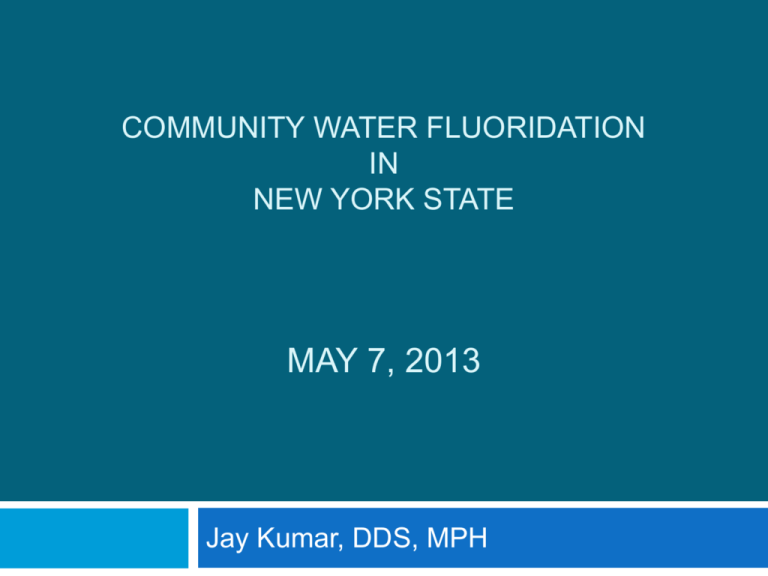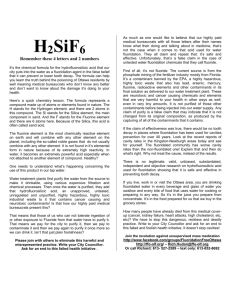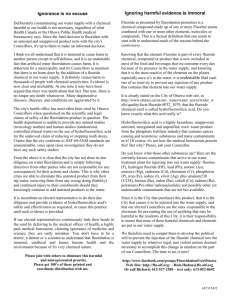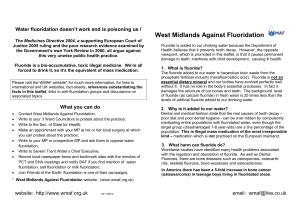Fluoridation in New York State - NYS Conference of Environmental
advertisement

COMMUNITY WATER FLUORIDATION IN NEW YORK STATE MAY 7, 2013 Jay Kumar, DDS, MPH Why Do Cavities Matter? Dental Caries Facial Cellulitis Dental Extraction Dental Caries Dental Caries Teeth problems caused by cavities Source: Pew Children’s Dental Campaign June 22, 2012 Goal #5: Reduce the prevalence of dental caries among NYS children. Prevention Agenda Target 2017. Third-grade children 50 45 40 35 30 25 20 15 10 5 0 Medicaid (2-20) 46 45.4 42 40 24 Prevalence 45 40.8 21.6 Untreated Sealant Dental Visit Fluoridation: Increase from 71.4% to 78.5% Why water fluoridation? Reduces cavities by up to 40% — for both children and adults Helps Americans keep their teeth Saves millions in treatment costs and eliminates pain and suffering Nearly every large city and more than 204 million Americans benefit CDC: One of the 10 great public health achievements of the 20th century Source: Pew Children’s Dental Campaign A Public Health Achievement “Fluoridation is the single most important commitment a community can make to the oral health of its children and to future generations.” Dr. C. Everett Koop Surgeon General (1982-1989) “Fluoridation is the single most effective public health measure to prevent tooth decay and improve oral health over a lifetime, for both children and adults.” David Satcher, MD, PhD Surgeon General (1998-2002) One of water fluoridation’s biggest advantages is that it benefits all residents of a community—at home, work, school, or play— through the simple act of drinking fluoridated water. Regina M. Benjamin, MD, MBA Surgeon General Source: Pew Children’s Dental Campaign Fluoridation in New York State Fluoridation efforts started in 1942 Newburgh initiated fluoridation in 1945 Focus on research and evaluation Approximately 12.5 million residents or approximately 72% on public water supplies receives fluoridated water The Weight of Science Opposition to Fluoridation June 22, 2012 Mean claim per recipient for caries related procedures was correlated with county fluoridation status 1.66 1.33 1.23 Spearman Correlation Coefficient -0.53 (p < 0.01). Each bubble denotes the size of the Medicaid population. Savings from Water Fluoridation: What the Evidence Shows Louisiana: A statewide analysis of Louisiana Medicaid reimbursements for caries-related procedures delivered to children, aged 1 to 5 years - Savings $66.8 per child A Texas study confirmed that the state saved $24 per child, per year in Medicaid expenditures. A 2010 study in New York State - $23.65. Researchers estimated that in 2003 Colorado saved nearly $149 million in unnecessary treatment costs by fluoridating public water supplies—average savings of roughly $61 per person. Scientific Review National Research Council Report – Fluoride in Drinking Water (2006) Griffin SO et al. Effectiveness of fluoride in preventing caries in adults. Journal of Dental Research 2007;86(5):410–414. Scientific Committee on Health and Environmental Risks of the European Commission (SCHER 2011) EPA Reports Fluoride in Drinking Water: Proposal to Change Standards EPA Drinking Water Standards Maximum Contaminant Level Goal (MCLG) – 4 mg/L Maximum Contaminant Level (MCL) Secondary Maximum Contaminant Level (SMCL) – 2 mg/L 4.0 3.6 3.2 2.8 2.4 2.0 CDC Recommendations for Fluoridation (0.7 -1.2 mg/L) 1.6 New York State Standards 0.8 Fluoridation Target is 1 mg/L ( Range 0.8 -1.2) State MCL is 2.2 mg/L 1.2 0.4 0.0 News Release FOR IMMEDIATE RELEASE January 7, 2011 Contact: OASH ashmedia@hhs.gov 202-205-0143 EPA isa.jalil@epa.gov or 202-564-3226 HHS and EPA announce new scientific assessments and actions on fluoride Agencies working together to maintain benefits of preventing tooth decay while preventing excessive exposure WASHINGTON – The U.S. Department of Health and Human Services (HHS) and the U.S. Environmental Protection Agency (EPA) today are announcing important steps to ensure that standards and guidelines on fluoride in drinking water continue to provide the maximum protection to the American people to support good dental health, especially in children. HHS is proposing that the recommended level of fluoride in drinking water can be set at the lowest end of the current optimal range to prevent tooth decay, and EPA is initiating review of the maximum amount of fluoride allowed in drinking water. ************************************************************************ HHS’ proposed recommendation of 0.7 milligrams of fluoride per liter of water replaces the current recommended range of 0.7 to 1.2 milligrams. Reasons Americans have access to more sources of fluoride than they did when water fluoridation was first introduced in the United States in the 1940s. The prevalence of dental fluorosis has increased. Severe enamel fluorosis is the clinical end point for setting EPA standards. EPA and HHS scientific assessments to balance the benefits of preventing tooth decay while limiting any unwanted health effects show that this can be achieved at 0.7 mg/L. Lack of association between daily temperature and children’s water intake in the United States. Tooth Decay Dental Fluorosis National Research Council Report – Fluoride in Drinking Water (2006) The Committee considered three toxicity end points for which there were sufficient relevant data for assessing the adequacy of the MCLG for fluoride to protect public health: severe enamel fluorosis, skeletal bone fluorosis, and fractures. Prevalence Severe Fluorosis Prevalence of Severe Enamel Fluorosis below 2 mg/L F, NRC Report 2006 30 EPA’s Point of Departure 25 20 15 10 5 0 0 1 2 3 Fluoride Level (ppm) 4 EPA ASSESSMENT The data in Table 8-2 indicate that some children drinking water at the 90th percentile intake level up to about age 7 are being exposed to fluoride on a daily basis at levels at or higher than estimated acceptable intake levels when the concentration of fluoride in their drinking water is at or above 0.87 mg/L. Strong evidence exists that the prevalence of severe enamel fluorosis is nearly zero at water fluoride concentrations below 2 mg/L. 2006 National Research Council Report – page 294 Reduce the MCLG of 4 mg/L Water fluoride Prevalence 4 mg/L ~10% <2 mg/L ~0% Conclusion that the MCLG should protect against severe enamel fluorosis is consistent with recommendations of Institute of Medicine (IOM). IOM (1997) Age-specific tolerable upper intake levels (UL) Set to reduce moderate enamel fluorosis Strategies to promote fluoridation Build support - Internal & External Engage partners and stakeholders State Oral Health Coalition Rural Water Association Local Health Departments State Dental Association Foundations Develop resources Provide training Explore financing options Resources New York State Department of Health (NYSDOH) website CDC and ADA Technical Assistance Center in Rochester ILikeMyTeeth.org - NewYork.ILikeMyTeeth.org Fluoride Science.org Rural Water Association Local Health Department Water Fluoridation Manual Fluoridation Manual Addresses Benefits Safety concerns Cost Operations and Engineering Contains: Articles Fact sheets and official statements New York specific information NewYork.ILikeMyTeeth.org Component website on ILMT Features information specific to NYS including: NYS laws and regulations Electronic copy of fluoridation manual New York fluoridation maps Links to other fluoridation websites Fact sheets and resources FluorideScience.org Topic summaries Critical appraisals Videos featuring fluoride researchers Training New York Rural Water Association (NYRWA) Operations and Engineering Benefits Safety concerns Technical Assistance Thank you jvk01@health.state.ny.us








